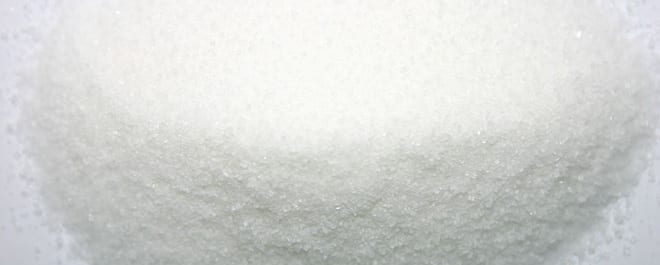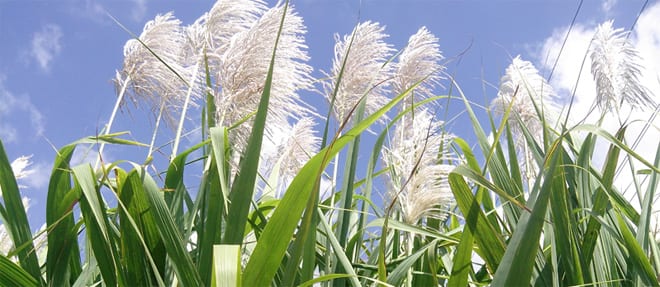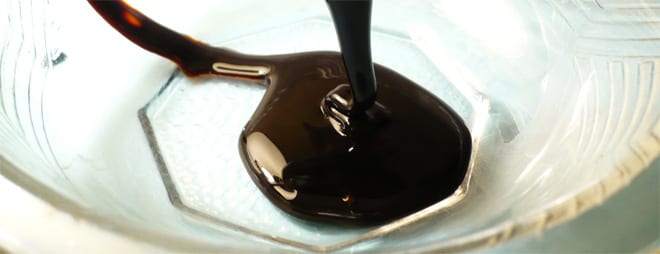
The compound known as table sugar is sucrose. Sucrose is a disaccharide, a type of sugar made from two sugar units: glucose and fructose. The two undergo a condensation reaction, during which water is removed, and the result is a powdered compound. Today, table sugar is industrially extracted from sugar cane and sugar beet.
Table sugar is very nutritious. For this reason, it is widely consumed. It is used in cooking to give a sweet taste to food. Sugar is a carbohydrate, and has no vitamins or minerals. Just one spoonful of sugar has 16 calories.
Since sugar is present as an ingredient in most foods, special attention must be paid to sugar intake. Large amounts of sugar are dangerous to human health. In fact, refined sugar is one of the worst foods to eat. Care must be taken when choosing an alternative, because some can actually be worse than sugar, including some sweeteners that are widely regarded as "healthy" but are in fact the opposite.
Alternatives to sugar:
- Aspartame
- Agave
- Sucralose
Artificial sweeteners are worse than sugar
We analyse each of them:
Aspartame
Aspartame is a synthetic chemical composed of three ingredients: two amino acids and a methyl ester bond. The amino acids are phenylalanine and aspartic acid. In aspartame the ratio of these two amino acids is 50 percent phenylalanine and aspartic acid at 40 percent (with 10 percent methyl ester linkage, also known as wood alcohol, a known poison). In other words, on a percentage basis, it is a massive amount of two isolated unnatural amino acids that are simply not found in this ratio in nature, bound together by a known (toxic) poison.
Aspartame is a major threat to public health and can lead to birth defects, cancer and weight gain. It has also been linked to brain tumours.
Sucralose
Sucralose is a synthetic chemical created in a laboratory. In the patented five-step process to make sucralose, three molecules of chlorine are added to one molecule of sucrose (sugar).
Some argue that natural foods also contain chloride, which is true. However, in natural foods, chloride is connected with ionic bonds that dissociate easily. But in sucralose they are in a covalent bond and do not dissociate. In fact, there are no covalent bonds with chloride in organic compounds in nature, they only exist in man-made synthetic form.
Fructose
When we eat a diet that is high in calories and high in fructose, the liver becomes overloaded and begins to convert the fructose into fat.
Lustig and other scientists believe that excess fructose consumption may be a key cause of many of today's most serious diseases, These include obesity, type II diabetes, heart disease and even cancer.
If we consume a large amount of fructose in the form of added sugars, the following can happen:
- The liver synthesises fats that are exported as VLDL cholesterol, leading to dyslipidaemia (blood triglycerides and cholesterol), fat around organs and ultimately to heart disease.
- They increase uric acid levels, leading to gout and high blood pressure.
- Fat deposition in the liver can lead to non-alcoholic fatty liver disease.
- It causes insulin resistance, which eventually leads to obesity and type II diabetes.
- Insulin resistance leads to elevated levels of insulin and insulin-like growth factor (IGF-1) throughout the body, which can ultimately cause cancer.
- Fructose does not affect satiety in the same way as glucose, so we automatically eat more total calories if our fructose intake is high.
- Excess fructose consumption can cause leptin resistance, throwing body fat regulation out of control and contributing to obesity.
- Sugar can be downright addictive.
Agave
Agave nectar is a sweetener made from the juice of the agave. This plant, which is related to aloe, likes arid climates and can be found mainly in the deserts of Mexico. Considered a healthy alternative to traditional sweeteners such as honey and sugar, agave honey is high in fructose, and as a result carries the risk of negative health effects.
These are some of the dangers of agave honey.
- May contribute to heart disease: Agave nectar is very high in fructose. Modern diets contain much higher levels of fructose, and our bodies cannot process it fast enough, so it enters the bloodstream as triglycerides. High levels of triglycerides in the blood can contribute to heart disease.
- Causes weight gain: Fructose can inhibit the production of leptin, the hormone that causes the feeling of fullness when you are full. Therefore, fructose increases appetite and contributes to weight gain.
- Not safe for diabetics: When you eat sucrose, e.g. honey, your body processes it into glucose or blood sugar. However, your body processes agave nectar into blood fats or triglycerides.
- Agave nectar can lead to mineral deficiency: There is some evidence to suggest that the high levels of fructose in agave honey may impede copper metabolism, leading to decreased production of collagen and elastin in the body. This can damage the body's connective tissues and lead to weakened bones, bone deformity, anaemia, infertility and heart disease.
- Agave nectar can cause liver damage. Consuming agave honey instead of sugar, honey or another traditional sweetener causes fatty deposits to form in the liver, and can eventually lead to cirrhosis. That's because, unlike other sugars, fructose cannot be metabolised by all the cells in the body, but must be metabolised by the liver, which converts it into fats.
The therapeutic benefits of molasses
Sugar cane is a tropical grass that has been cultivated by humans for thousands of years. Sugar cane is a deep-rooted grass buried about fifteen feet underground. It collects trace elements from the soil and subsoil, the minerals our bodies need.

Making what we know as table sugar from sugar cane can vary from a relatively simple process to a multi-step process, and the end result varies depending on the specific steps in the process. Dark and light brown sugar, icing sugar and white granulated sugar are all highly refined, while others, such as those listed below, are made with fewer steps in the processing chain. Fewer steps benefit the environment, because less processing means less environmental impact. It also means that more of the vitamins and minerals that naturally make up sugar cane remain in the final product.
Molasses, unlike other sugar cane sweeteners, contains significant amounts of vitamins and minerals. First molasses is the molasses that remains when the sugar cane juice is boiled, cooled and its crystals removed. If this product is boiled again, the result is called second molasses. Third molasses, which is made from the third boiling of the sugar syrup, is the most nutritious and contains substantial amounts of calcium, magnesium, potassium and iron.

According to the United States Department of Agriculture, 100 grams of raw blackstrap molasses contains the following composition of minerals and vitamins:
- Calcium: 684 mg
- Phosphorus: 84mg
- Iron: 16.1 mg
- Sodium: 96mg
- Potassium: 2,927 mg
- Magnesium. 258 mg
- Thiamine: 11 mg
- Riboflavin: 19 mg
- Niacin: 2mg
According to noted dietary expert Gaylord Hauser, molasses is extremely high in Vitamin B6, pantothenic acid and Inositol and should be put on the table as regularly as salt and used as a sugar substitute in cereals and eaten in place of jam or jelly.
High nutritional value molasses - containing all the minerals and nutrients absorbed by the plant - is more likely to be sold as livestock feed. Fortunately, the nutritional value of molasses is becoming more widely known - and various grades of molasses are now sold as baking ingredients, sugar substitutes and mineral supplements.
Health benefits of molasses
Below is a list of health benefits of molasses, and some advice on how to consume it as a health supplement:
- Good for your hair - One serving (two tablespoons) of molasses contains approximately 14 percent of our recommended daily allowance (RDI) of copper, an important mineral whose peptides help rebuild the skin structure that supports healthy hair. Consequently, long-term consumption of molasses has been linked to improved hair quality, hair growth in men and even a restoration of their original hair colour.
- Safe sweetener for diabetics - Unlike refined sugar, molasses has a moderate glycemic load of 55. This makes it a good sugar substitute for diabetics and people who are trying to avoid blood sugar spikes. In addition, one serving of molasses contains no fat and only 32 calories, making it suitable for a weight loss diet.
- Laxative qualities " Molasses is a natural stool softener that can improve the regularity and quality of bowel movements.
- Rich in iron - Two tablespoons of molasses contain 13.2 percent of our daily requirement of iron, a mineral our body needs to transport oxygen to our blood cells. People suffering from anaemia (including pregnant women) will benefit greatly from consuming 1-2 tablespoons of molasses per day.
- High in calcium and magnesium - Molasses contains a mineral profile that has been optimised by nature for superior absorption. For example, two tablespoons of molasses contain 11.7 percent of our RDI of calcium and 7.3 percent of our RDI of magnesium. This calcium-to-magnesium ratio is ideal, as our bodies need large amounts of magnesium to help absorb equally large amounts of calcium. Both minerals support bone growth and development, making molasses a good protection against osteoporosis and other bone diseases.
- Additional mineral content - Two tablespoons of molasses also contain 18 percent of our recommended daily intake of manganese (which helps produce energy from protein and carbohydrates), 9.7 percent of our RDI of potassium (which plays an important role in nerve transmission and muscle contraction), 5 percent of our RDI of vitamin B6 (which aids brain and skin development) and 3.4 percent of our RDI of selenium, an important antioxidant.
The best way to supplement with molasses is to mix 1-2 tablespoons of molasses in a cup of boiling water and drink it through a straw once the water cools down. This should be done every day, mainly in the morning when we need the most energy.
Scientist Ciryl Scott wrote the book Crude Black Molasses: The Natural Wonderwhere you can find out all about molasses and its properties.


2 thoughts on “El azúcar refinado y los endulzantes”
Very clear answer to the question I asked about molasses. Thank you very much ..... Can you help me? I need to find machines to do MRI diagnostics.
I live in Mexico and want to set up a practice with a responsible Doctor, to support people who lack possibilities in all aspects..... My friend Dr. in Soria is working on the Vademecum of Homeopathy and he is the one I am going to work with....
Very grateful indeed!!!
What a good explanation...I was afraid to take it because of the sugar ceiling according to lab tests but I can see that it is not harmful.
Comments are closed.